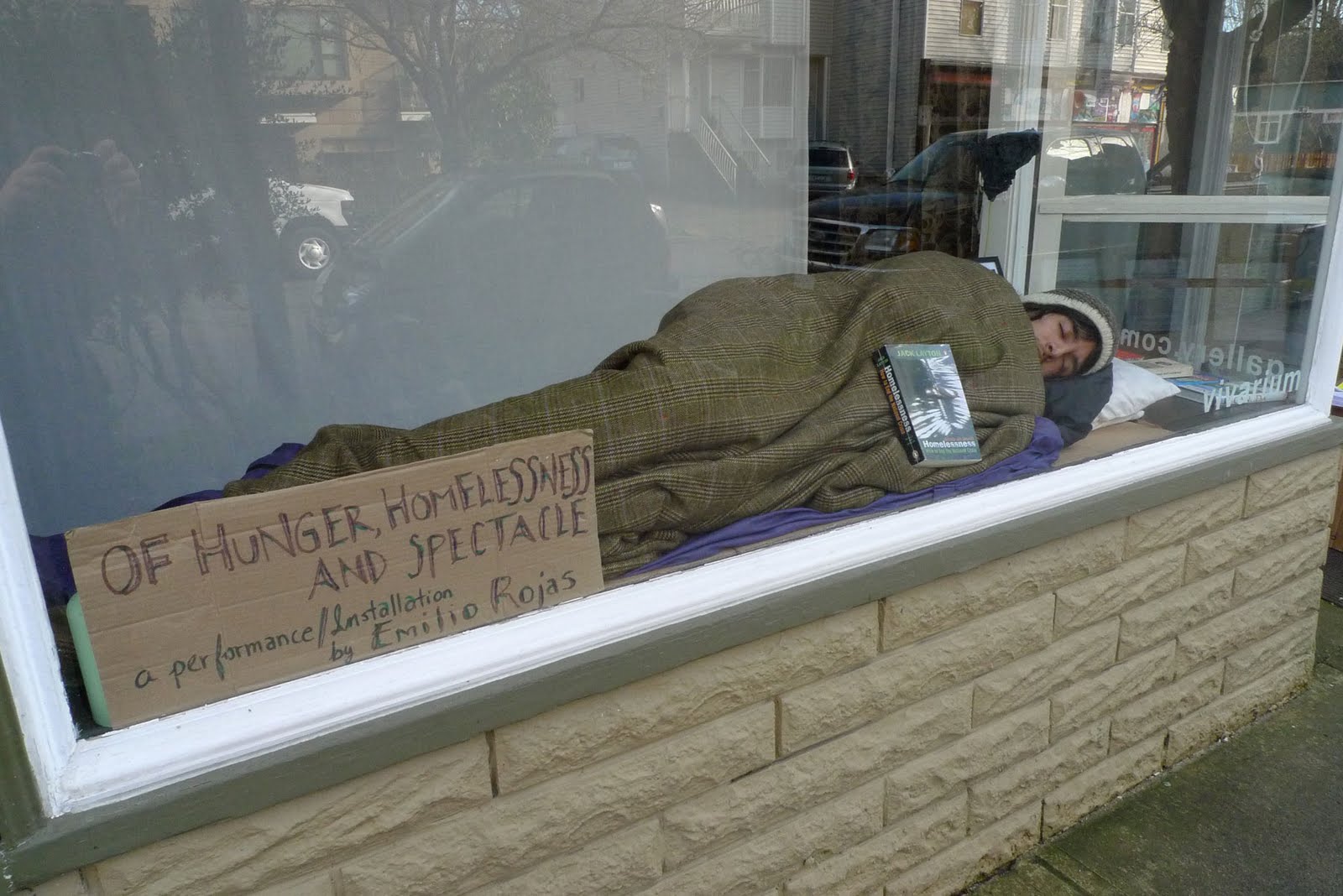Two pro-social housing campaigns have joined together to create awareness about homelessness and the need for a national housing strategy. Emilio Rojas, a performance multimedia artist and participant with the 2010 Homelessness Hunger Strike Relay, is using one of Pivot Legal Society’s red tents as part of his action. Sleeping in the front window of Vivarium Gallery until Sunday as part of a Performance/Installation entitled “Of Hunger, Homelessness and Spectacle,” Rojas has created a mock street scene complete with books on homelessness, a cardboard sign, a shopping cart, a sleeping bag; and a prominently placed red tent. Videos highlighting the experiences of homeless persons are also displayed behind him.
Vivarium curator jammie griffiths is also participating in the hunger strike, though not in the performance.
Rojas is one of over 70 people who have given up all solid substances for a week’s time to raise awareness about homelessness since the Relay began in December 2008. High profile members have included David Eby, Executive Director of the British Columbia Civil Liberties Association, and University of British Columbia (UBC) professor and anti-Olympic activists Chris Shaw. Participants pass a wooden spoon to one another each week as a “symbol of struggle,” says Rojas.
Am Johal, Relay organizer, explains: “We’ve wanted this to include as many people as possible. The idea is that homeless people would participate. We’ve had six or seven current or former homeless persons, we’ve had doctors, lawyers, professors…people from all walks of life participate.
“Some people are long time social activists and some are new to the issues,” continues Johal.
The demand of the hunger strikers is simple: implement a national housing strategy similar to that in place post WWII. Dr. Michael Byers, professor of international law at UBC and Relay participant, explains: “this hunger strike for homelessness is directed primarily at getting the Canadian federal government to re-institute a comprehensive national affordable housing programme. Canada had the very best programme in the world between 1973 and 1993, and then in 1993 that programme was cut.” Responsibility was then placed on provincial and city governments, who also instituted cutbacks in the late 1990s.
“We used to be one of the leaders on housing programmes and fighting homelessness, and now the UN has declared homelessness a national crisis,” says Rojas. “How could we go from being a leader to being a disgrace?”
The specifics for a national housing strategy are based on “the One Percent Solution.” A 1998 study by Dr. David Hulchanski of the University of Toronto showed that before the 1990s all levels of governments spent one percent of their total budgets on housing. Advocates claim that re-instituting this small percent of funds would dramatically change options for those who are homeless and low-income.
Says Johal, “to house someone costs $28,000 a year, to leave them out on the streets costs $55,000 a year. We’ve made the decision as a society that [the Olympics] is somehow a good way to spend public money. We want to refocus the agenda in the country to deal with things that matter.”
Pivot’s Red Tent campaign has the same demand, and will be joining the Relay with the Impact on Communities Coalition at a rally for a national housing strategy, taking place Saturday at the Vancouver Art Gallery. Groups concerned with homelessness and housing have been coordinating their actions throughout the Vancouver 2010 Olympics. “It’s all connected,” says Johal. “And it’s for the exact same thing.”
The Relay will continue until June 2010, when hunger strike participants will go to Ottawa to demand a national housing strategy. Their journey will take place on the 75th anniversary of the On-to-Ottawa Trek, in which hundreds of unemployed men took trains to Parliament Hill, demanding job creation at the height of the Great Depression.
“We want to tie historic actions to what we’re doing,” says Johal. “We’re going to be working with the labour movement and others.” Johal notes that money is being raised to include homeless and low-income persons on the trip.
While many Relay participants have chosen to remain anonymous, others have used their status as public figures to raise awareness. Rojas explains: “Ellen Woodsworth, the city councilor, was right before us…she was out in the streets giving our pamphlets on the homelessness situation in Canada. And I think that’s a very political way of doing things, and that’s her force, her strength.
“In my case it’s art, it’s doing performance. I think the bridge between art and activism needs to be connected, I think we need to create awareness through art.”
Rojas continues: “For an artist, visuals talk more than anything else. My piece displays that homelessness is both a spectacle and being ignored at the same time.”
Rojas hopes that his piece will help to create awareness about issues of homelessness in Canada. “By avoiding the Downtown Eastside, people are avoiding a whole situation. But they need to realize that a lot of people are homeless, not just the people we usually associate like drug users and sex workers.”



